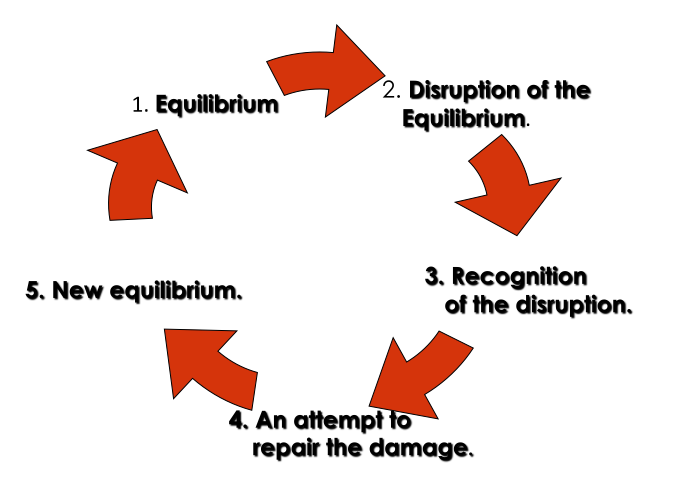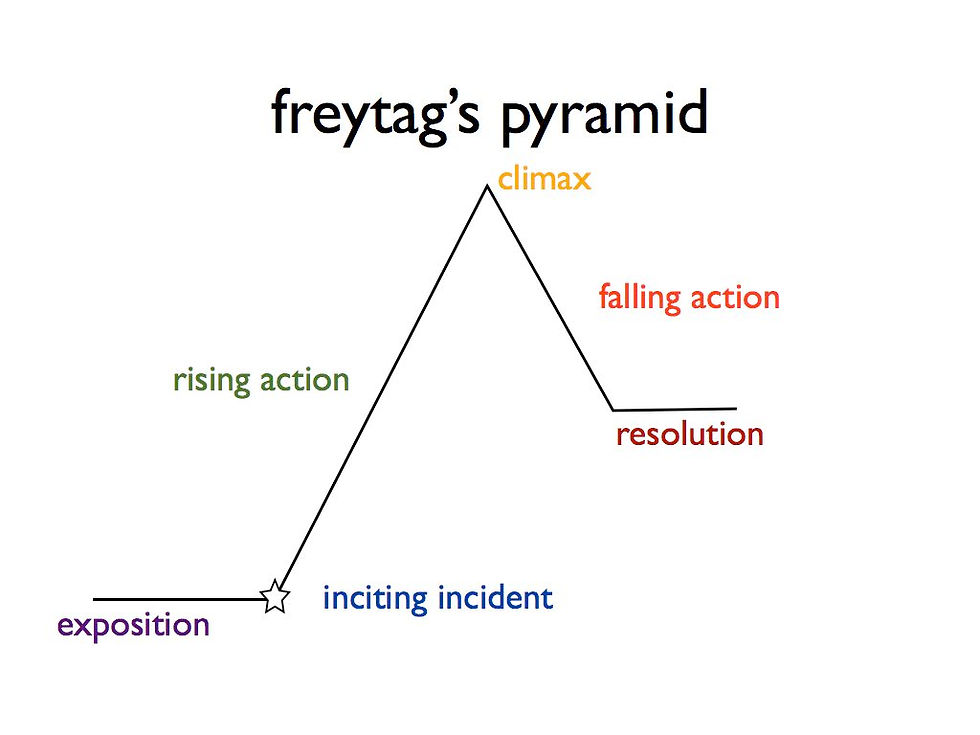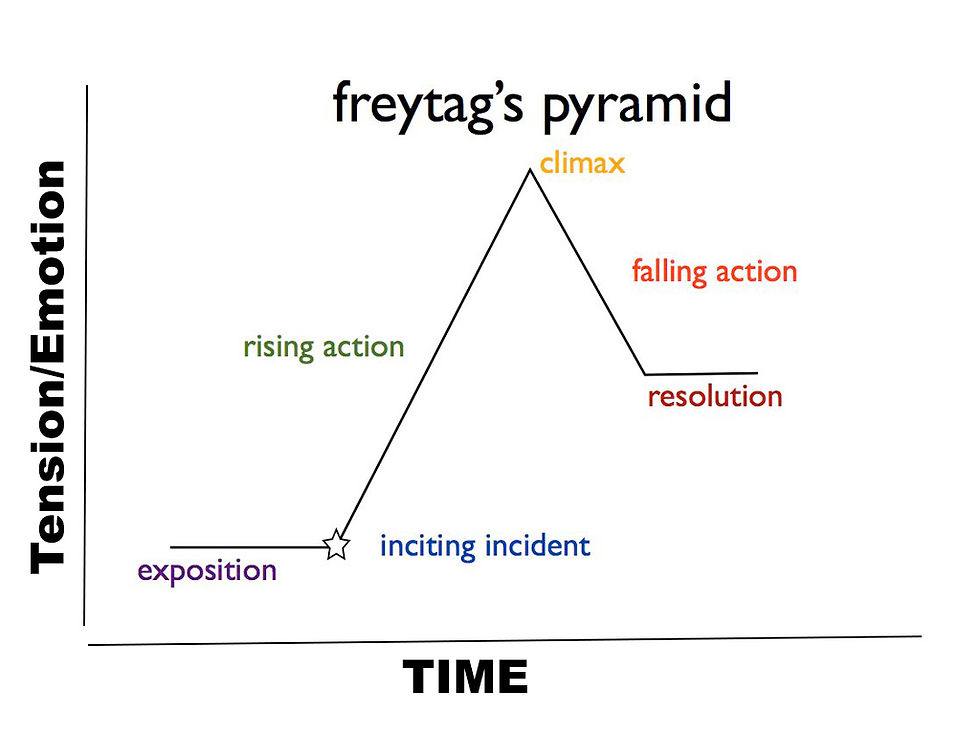March 11th - 2022: Elements of a Narrative
- havenmilne20
- Mar 11, 2022
- 8 min read
Before having started this project, I have been doing creative writing since I really became a creative as one could call it, as far back as I can remember, wanting to express my stories in words or in visuals, and to whoever wanted to take a look or had an interest.
Having the chance now to truly tell a story from start to finish, even though being short, has opened a few doors in my head and enlightened me to a few issues which need to be covered.
One of those being: How on earth do I plan and finish the story that I want to tell? This specifically being in the written format, since I will be writing a comic script even before I start to sketch, draw or print a single panel for this comic.
So what is in the narrative, what are the elements?
Let's start with something all writers should know, and is taught to those studying anymore of narrative, be it in film, poetry, stage productions and written fiction/non-fiction: Todorov's Theory.
In 1969, Tzvetan Todorov proposed a theory about how a story structure should be divided up and how each of the sections fluidly moves from one to the next, allowing for a story to start and end correctly as the writer wants it to end. Even though this theory is very much lenient towards film narratives, I can see that it can also be used to help structure and form a narrative in another medium, such as a novel or a comic.
He proposed that there are five parts of a narrative, and this is them in the same order as he proposed them:
Equilibrium (1st): This is the first stage of the story, in which all aspects of the world which the story's characters exist in, are in balance with one another. Essentially everything is as perfect as everything can be.
Disequilibrium: This is the stage in which the balance of the characters and the world are disturbed by an event or action caused by someone or something that exists as well in the same world.
Acknowledgement: This is the stage in which the characters or world of the story, have now begun to understand what has happened, how it has affected them, how it will continue to affect them and so on and so on.
Solving: This is the stage in which the characters and the world have now begun to solve and repair the implications made by the 'Disequilibrium' and restore balance to the world and characters of the story.
Equilibrium (2nd): This is the stage in which the world and the characters have now returned to balance. This is often a moment when the characters are in celebration, mourning and neutral emotion, depending on the narrative of the story. Sometimes the 'Second Equilibrium' (or New Equilibrium) can be setting up a follow-up in another narrative later on, not fully returning balance to the universe, but giving the world and its characters a sense of stability (instead of balance) until the story can be finished and returned to the state of Equilibrium.
(Digram of Todorov's theory shown below)

This simple structure, even though using a selection of somewhat complicated words, can help a writer, and possibly help me, plan out the narrative. A writer could behind to generate ideas for their story and piece them together on a timeline, and then use these sections and lay them on top of the time line to help show where each of the sections starts and ends within the parts of their story which they have created.
Now, to help you understand what I am talking about, let me put this theory into context and show it being used in a well know film: STAR WARS - Episode IV: A New Hope (or just STAR WARS if you are a die hard fan like me, THERE ARE ONLY THREE FILMS!)
Equilibrium (1st): Luke is on Tatooine, wasting away as a moister farmer. Princess Leia is running away from the Empire wit plans of a secret weapon which threatens the universe. Leia hides said plans in a droid and send it to the remote desert plans of Tatooine in hope of the droid reaching Obi-wan Kenobi.
Disequilibrium: The Death Star, the Empire's super weapon, destroys the planet Alderaan, homeworld of Princess Leia, in hope of retrieving information from her about the whereabouts of the droid and the plans. With this, a galaxy wide manhunt begins for the Rebel Alliance, helmed by the Sith Lord, Darth Vader. Meanwhile, Luke retrieves the droids after they are captured and sold to him, finds a distress message from Princess Leia in the droid asking for help from Obi-wan Kenobi, who Luke thinks is Old Ben, a hermit who lives far away from town. Luke finds ben, then learns his aunt and uncle have been killed by the Empire, supposedly because they won't say where Luke or the droids are. Together, Luke and Kenobi hire a smuggler called Han Solo and Chewbacca the Wookie, to take them to Alderaan and save the Princess.
Acknowledgement: Luke and his new companions arrive at where Alderaan would have once been, only to find that it has now been destroyed by the Death Star, which they are unwillingly pulled into by a tractor beam and brought aboard. The group fights their way through the super weapon, disguised as Stormtroopers, soldiers of the empire. Eventually, they rescue the princess and escape the station, only with the cost of Obi-wan Kenobi, engaging in a Jedi duel of lightsabers against Darth Vader, ultimately sacrificing himself in order for Luke and his companions to save themselves as he is no match for his old apprentice, now turned evil, turned to the dark side of the force. The group of humans, machinery, aliens and royalty arrive on Yavin 4, the forest moon which hosts the secret Rebel Alliance base, in which the whole Rebel Alliance learns of the confirmed existence of the Death Star.
Solving: The Rebel Alliance prepares for battle, using the plans of the super weapon which were hidden inside one of the droids following Luke and his companions around, and strategise their attack pattern, discovering a weak point for their fighters to strike. Next comes the long and epic fight sequence in which the Rebel Alliance manages to blow up the Death Star (not mentioning the millions of lives they have killed since it takes that many people to run such a super weapon), but not without losing their own. The Empire is forced away for a time and rethink their war with the Rebel Alliance after losing their most expensive and power asset, and Darth Vader in flung far out into space.
Equilibrium (2nd): The Rebel Alliance, having only won this battle, rejoices in celebrations on Yavin 4, awarding Luke and Han Solo (and for some reason not Chewbacca) medals for their bravery and success of destroying the Death Star (and killing millions of people). Even though they won, the Empire still exists and the war carries on, only now with more help and 'friends.' THEN CAME TO EPIC SEQUELS WHICH FINISHED THE STORY, NOT INCLUDING THE SEQUEL OR PREQUEL TRILOGY!
Okay, that may have been a lot to read, but at least it makes more sense of what I trying to get across to you. You can easily see how easy it is it can be used to break down the story a writer is trying to create or a story which already exists for analysis, like I have sort of done above.
With this, one can also use this by helping to give an original story the tone and feeling which each of the sections needs to work individually and overall together as a complete narrative, even if the story has no official ending or an open ending like I have previously mentioned.

Now, on the other hand, I have also discovered another aspect of creating a narrative, which is every similar to Todorov's Theory. I found something known as 'Freytag's Pyramid', created in the 19th century by German playwright Gustav Freytag.
There are two major differences with Freytag's Pyramid when compared to Todorov's Theory.
The first of these differences being that the pyramid consists of seven elements instead of just five sections. These parts are, in order of occurrence according to Freytag are: Eposition, Inciting Incident, Rising Action, Climax, Falling Action, Resolution.
The other different being that even though both of the two theories have a resolution, or repairing of equilibrium, yet the big different with Freytag's pyramid is that the ending element is higher than that of Todorov's. Now what do I mean by that?
Its hard to see so let me show you this:

Here is the same diagram, but this time I have now added some chart aspects to it. Along the X axis is TIME, time in which passes in the story/narrative. Along the Y axis is the level of emotion and tension which rises and falls during the story/narrative, depending on what part of the story is happening.
So, here we go! As time goes on and moves forward, events also move forward, each one moving from one to the next. With each of the events happening, the level of tension/emotions rises slowly or quicl=kly or which ever way needed, in order to set a good pace and tone for the story, affecting both the characters and world which make up the story, and delivering a substancial amount of emotion/tension for the audience to feed off, grounding them into the story and connecting the audience with the characters.
Now back to what I was saying a few paragraphs ago. What did I mean by Freytag's ending is higher than Todorov's? Well, when looking at my edited graph, you can see how the resolution element of the pyramid sits higher than the elements which make up the start of the story, meaning that in Freytag's eyes that the ending of the story should sit higher in emotion and tension when compared to the start. One could say that this would be a 'uplifting ending?"
Now, even though this may be what Freytag is trying to convey to people, it is no always true. Some stories, biopics for instance, tell true stories and sometimes, like life, not every ending to a real persons life is a happy ending, sometimes it has to sit lowering than the beginning of the narrative, sitting lower than the 'exposition element' or not even resolving the 'second equilibrium', most likely because the film/biopic is trying to get a point a across and tell what is true.
For instance, take the film CONTROL, which tells the sad and true story of the legendary Joy Division singer, Ian Curtis, who, sadly after spending many years suffering from mental health problems and epilepsy, committed suicide in his home. Even though he rose to stardom, fell in love, had a family and released some of the greatest rock music in history, only to fall and shatter inside as no one at the time truly understood what he was suffering with, a time when men shouldn't be talking about emotions and if you had such conditions and suffered from such mental issues was considered retarded (sorry for the word, but it is the truth). He had no understanding of who he was, how to come and live in a world which didn't make sense to him, and become an adult with a life that was weighing down are on him in a time which was already hard for a lot of people.
If only people had the understanding of these issue back then like we do now, Ian Curtis would have had a much longer and healthier life, imagine what would have become of Joy Division.
Now, I myself do not believe in fate, but without the death of Ian Curtis there would have been no Blue Monday. It is a dark thought but without his death, New Order would not have formed in the wake of his suicide, and spark was made to start a fire which would change the way in which bands, and not the name, but the actual musicians themselves, were cared for and looked after.
The mental aspect of the music industry still isn't perfect today, it still needs a lot of work, but I'd say, without Ian Curtis, even though he sadly he took his own life, things don't change.
And like with a narrative, there needs to be a climax in the story, or the acknowledgment and solving elements before anything can actually change and an ending can actually happen.
References:
Chey, E., 2022. Freytag's Pyramid: 7 Elements, 5 Cool Examples of Dramatic Structure. [online] ClearVoice Blog. Available at: <https://www.clearvoice.com/blog/what-is-freytags-pyramid-dramatic-structure/#:~:text=What%20is%20Freytag's%20Pyramid%3F,action%2C%20resolution%2C%20and%20denouement.> [Accessed 11 March 2022].
Selina Argyrou. 2022. Todorov Theory. [online] Available at: <https://selinaargyrou.wordpress.com/todorov-theory/#:~:text=The%20equilibrium%20is%20the%20first,the%20characters%20lives%20are%20normal.&text=The%20second%20stage%20is%20the,disturbed%20by%20an%20event%20occurring.> [Accessed 11 March 2022].
Anderson, L., 2006. Creative Writing. Abingdon: Routledge in association with the Open University.


Comments